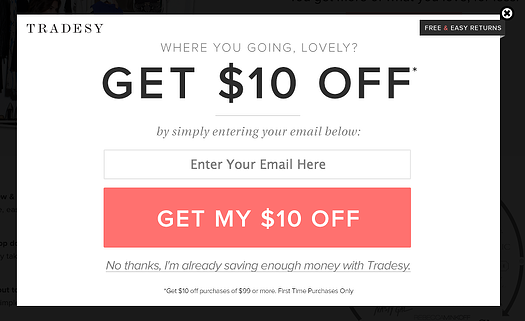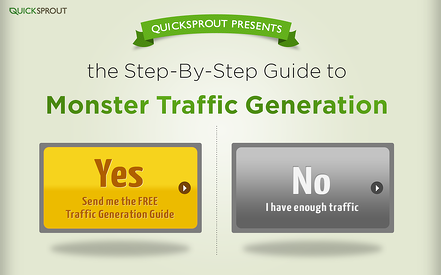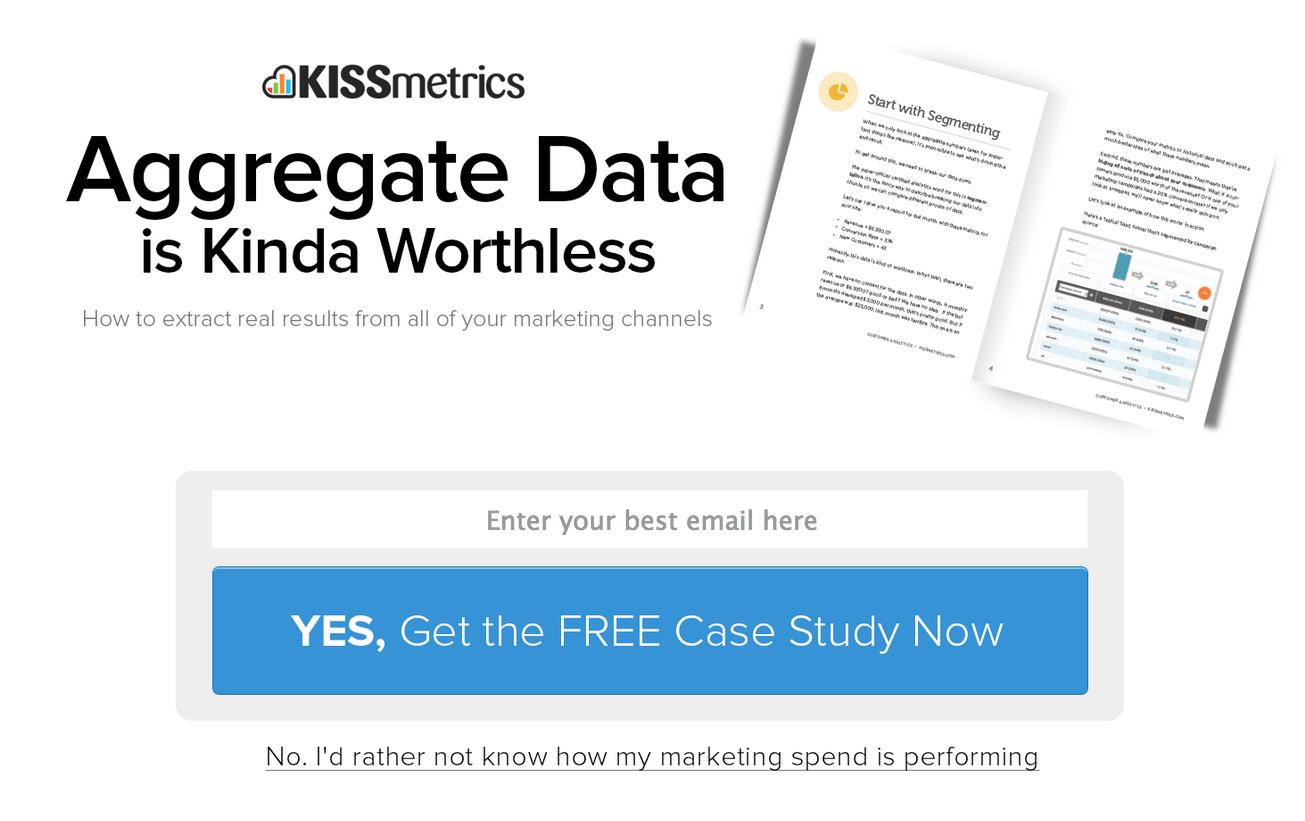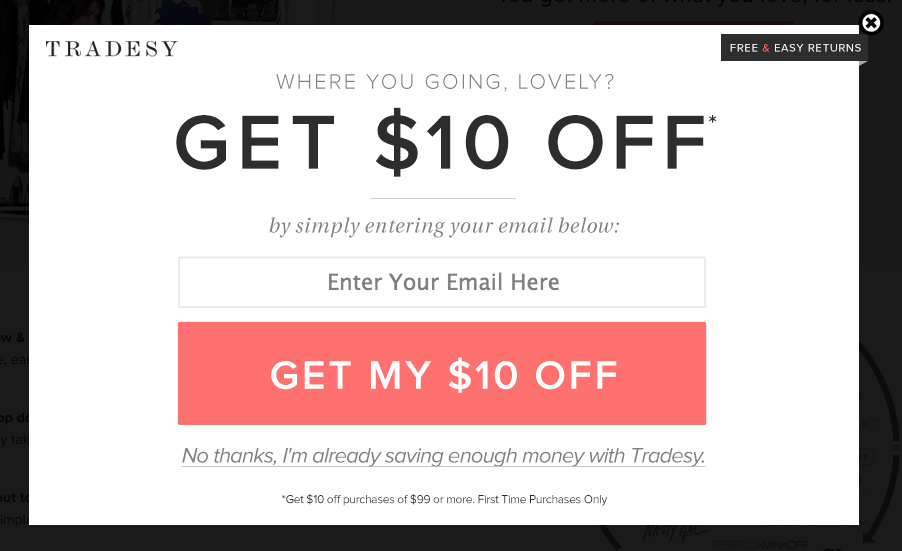Topics:
Lead GenerationJoin 40,000+ sales and marketing pros who receive our weekly newsletter.
Get the most relevant, actionable digital sales and marketing insights you need to make smarter decisions faster... all in under five minutes.
Do you ever have those moments where your inner-marketer carries over into your personal life?
For example, I'm known to refer to all written and visual material as content. Whether it's a take-out menu or a movie poster, it's all content.
But the other night I came face-to-face with my inner-marketer in an instance that I felt was really worth documenting. I was browsing a website called Tradesy for the first time, and I couldn't have been on the page for more than a minute before a pop-up jumped out with a passive aggressive one-liner:

Does anyone really fall for this kind of crap?
Regardless, I seized the opportunity to screenshot the call-to-action and stash it away for a future blog post.
So here we are now, in the introduction to this said blog post.
And while I don't have the data (yet) to persuade you one way or the other, I have a strong enough hunch that I'm not the only one curious about the effectiveness of this type of marketing.
Does it work? Who else is using it? I'm looking for answers.
What's passive aggressive messaging anyway?
Before I go any further, I want to be sure that I'm clear about what I'm referring to when I use the phrase passive aggressive marketing messaging.
In terms of marketing, passive aggressive messaging refers to an instance where you present a visitor with two choices, but position the desired action you want them to take as the only logical choice.
KISSmetrics and QuickSprout - both ventures of Neil Patel - rely on these types of call-to-action messaging in order to persuade action:


Judging by the massive success of both blogs, I'm sure this is effective. That's not the argument here. The question I'm proposing is would this work for you?
While a visitor probably wouldn't hesitate to exit a pop-up by clicking an 'x' in the corner, forcing them to admit that they "have enough traffic" or don't care about "how their marketing spend is performing", aims to alter their way of thinking.
Perhaps now they stop to ask themselves, "Wait, do I really have enough traffic?"
You have them rethinking their decision. You may have just saved the conversion.
Or, you may have just rubbed them the wrong way.
Here's how I felt:
Back to the call-to-action that started it all:

Maybe I would have liked to save $10 on my purchase from Tradesy, had I been ready to make a purchase in the first place. However, this pop up was presented to me while I was reading their about page, meaning that I hadn't even had a chance to see what I'd be saving $10 on before they were asking me for my email.
Point being, I often find this type of messaging to be way too assumptive.
After being interrupted, I had a chance to finish reading up on what Tradesy was all about. I learned that they served as an online thrift store in which users could either make purchases or list their own items for sale.
So had I been on the website just to list my own items, this pop-up would have been totally irrelevant to me, and passive aggressive on top of that.
In life, and marketing, 2 wrongs never make a right.
"The problem with these lines is they put words in the consumer's mouth.", says HubSpot's managing editor, Corey Eridon.
"Either way, they're probably wrong. If I like the business, I'll probably want to save more money with them. If I don't, or I don't use them enough to even want the savings -- it's just weird. In the end, a simple "No thanks" or a "Nah, I'm good" for a more colloquial brand would do the trick just fine."
We also reached out to Justine Jordan who runs the marketing over at Litmus. As someone who is always out to improve the customer experience, we thought her opinion would be valuable.
"My gut reaction to these messages is they make me angry. Of course I'm interested in more traffic, it's why I'm reading your site in the first place!
My usual response is to get passive aggressive in return. Real mature, right? I 'punish' the offender by ignoring the message. If the messages are persistent I'll leave the site altogether. You have to earn my information with great content, not by playing with my emotions, annoying me, or making me feel guilty. Presenting me with two crappy options and forcing me to choose the lesser of two evils? It's playing mind games with your audience!
Purposely creating cognitive dissonance for the user (I may want more traffic but I'm clicking a button that says I don't...) isn't exactly a great way to build trust. It feels like a cop-out—stop being lazy and start actually caring about your visitors. Provide them with value. Put their needs first. It's marketer-centric marketing rather than user-centric marketing. And it gives the people trying to do it right a bad name.
The worst part is that I know these work (it's why you see them everywhere now)."
Jason Diller, marketing director at The DSM Group, sees it from both sides.
"As a marketer, it's all about the data. If that tactic makes their target persona take action and ultimately buy a product and they've tested it against other variants, then data wins."
What are your thoughts?
Are you or anyone else you know employing this type of marketing messaging on your website? If so, how is it converting?
If you're not, what are your thoughts on this approach? Do you like it? Do you feel like it alters your decision making process?
We'd love to hear your feedback.
Free Assessment:

